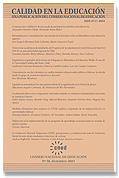Differences in the Implementation of a Social and Emotional Learning Program in Schools of Varied Sizes
DOI:
https://doi.org/10.31619/caledu.n59.1371Keywords:
Social and Emotional Learning, SEL Programs, Educational Leadership, School Size, Qualitative Research, Case StudyAbstract
In recent years, numerous studies have delved into the impact of universal and evidence-based Social and Emotional Learning (SEL) programs within the spectrum of pre-primary to secondary education. Implementation nuances significantly influence these programs’ efficacy, with school leaders playing a pivotal role in facilitating their integration into diverse educational contexts. This article presents a multiple case study examining the implementation of the Trabün SEL program in two schools of different sizes. Using a mix of individual and group interviews, this study aims to pinpoint key differences in factors influencing implementation. It also explores the strategies used by school principals and program heads to support Trabün SEL program implementation in their respective schools. The results show variations in the commitment and motivation of school principals, the willingness of teachers to participate, communication dynamics among participants, the working environment, and the strategies employed for program support and monitoring. The conclusions of this report carry significant implications for educational institutions promoting SEL programs, emphasizing the importance of effective communication management and the need for diversified support strategies and monitoring approaches tailored to schools of different sizes.
Downloads
Published
Issue
Section
License
Copyright (c) 2023 Calidad en la Educación

This work is licensed under a Creative Commons Attribution 4.0 International License.
Authors retain their Copyright and only transfer a part of these to the journal, accepting the following conditions:
Authors keep their rights as authors and guarantee the right to the journal for the first publication of their work, which is simultaneously subject to the Creative Commons Attribution license allowing third parties to share the study accrediting the author and first publication in this journal.
Authors may adopt other non-exclusive license agreements for distribution of the version of the published work (e.g. inclusion in an institutional thematic file or publication in a monographic volume) accrediting initial publication in this journal.
Authors are allowed and recommended to share their work over the Internet (e.g. in institutional telematic files or their website) before and during the submission process, which may lead to interesting exchanges and increased citation of the published work. (See The effect of open access).

